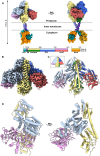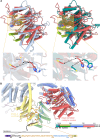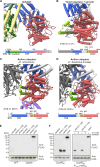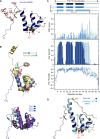Structural basis for regulation of a CBASS-CRISPR-Cas defense island by a transmembrane anti-σ factor and its ECF σ partner
- PMID: 39454004
- PMCID: PMC11506125
- DOI: 10.1126/sciadv.adp1053
Structural basis for regulation of a CBASS-CRISPR-Cas defense island by a transmembrane anti-σ factor and its ECF σ partner
Abstract
How CRISPR-Cas and cyclic oligonucleotide-based antiphage signaling systems (CBASS) are coordinately deployed against invaders remains unclear. We show that a locus containing two CBASS and one type III-B CRISPR-Cas system, regulated by the transmembrane anti-σ DdvA and its cognate extracytoplasmic function (ECF) σ DdvS, can defend Myxococcus xanthus against a phage. Cryo-electron microscopy reveals DdvA-DdvS pairs assemble as arrow-shaped transmembrane dimers. Each DdvA periplasmic domain adopts a separase/craspase-type tetratricopeptide repeat (TPR)-caspase HetF-associated with TPR (TPR-CHAT) architecture with an incomplete His-Cys active site, lacking three α-helices conserved among CHAT domains. Each active site faces the dimer interface, raising the possibility that signal-induced caspase-like DdvA autoproteolysis in trans precedes RseP-mediated intramembrane proteolysis and DdvS release. Nuclear magnetic resonance reveals a DdvA cytoplasmic CHCC-type zinc-bound three-helix bundle that binds to DdvS σ2 and σ4 domains, undergoing σ4-induced helix extension to trap DdvS. Altogether, we provide structural-mechanistic insights into membrane anti-σ-ECF σ regulation of an antiviral CBASS-CRISPR-Cas defense island.
Figures








Similar articles
-
Multifactorial control of the expression of a CRISPR-Cas system by an extracytoplasmic function σ/anti-σ pair and a global regulatory complex.Nucleic Acids Res. 2018 Jul 27;46(13):6726-6745. doi: 10.1093/nar/gky475. Nucleic Acids Res. 2018. PMID: 29893914 Free PMC article.
-
The CarD/CarG regulatory complex is required for the action of several members of the large set of Myxococcus xanthus extracytoplasmic function σ factors.Environ Microbiol. 2014 Aug;16(8):2475-90. doi: 10.1111/1462-2920.12386. Epub 2014 Feb 20. Environ Microbiol. 2014. PMID: 24428729
-
The role of C-terminal extensions in controlling ECF σ factor activity in the widely conserved groups ECF41 and ECF42.Mol Microbiol. 2019 Aug;112(2):498-514. doi: 10.1111/mmi.14261. Epub 2019 Jun 11. Mol Microbiol. 2019. PMID: 30990934
-
Mechanisms of Action of Non-Canonical ECF Sigma Factors.Int J Mol Sci. 2022 Mar 25;23(7):3601. doi: 10.3390/ijms23073601. Int J Mol Sci. 2022. PMID: 35408957 Free PMC article. Review.
-
ECF σ factors with regulatory extensions: the one-component systems of the σ universe.Mol Microbiol. 2019 Aug;112(2):399-409. doi: 10.1111/mmi.14323. Epub 2019 Jun 26. Mol Microbiol. 2019. PMID: 31175685 Review.
Cited by
-
Milestones in the development of Myxococcus xanthus as a model multicellular bacterium.J Bacteriol. 2025 Jul 24;207(7):e0007125. doi: 10.1128/jb.00071-25. Epub 2025 Jun 17. J Bacteriol. 2025. PMID: 40525847 Free PMC article. Review.
-
'Intelligent' proteins.Cell Mol Life Sci. 2025 Jun 14;82(1):239. doi: 10.1007/s00018-025-05770-1. Cell Mol Life Sci. 2025. PMID: 40515853 Free PMC article. Review.
References
-
- Millman A., Melamed S., Leavitt A., Doron S., Bernheim A., Hör J., Garb J., Bechon N., Brandis A., Lopatina A., Ofir G., Hochhauser D., Stokar-Avihail A., Tal N., Sharir S., Voichek M., Erez Z., Ferrer J. L. M., Dar D., Kacen A., Amitai G., Sorek R., An expanded arsenal of immune systems that protect bacteria from phages. Cell Host Microbe 30, 1556–1569.e5 (2022). - PubMed
MeSH terms
Substances
LinkOut - more resources
Full Text Sources

